towing FORD MAVERICK 2022 Owners Manual
[x] Cancel search | Manufacturer: FORD, Model Year: 2022, Model line: MAVERICK, Model: FORD MAVERICK 2022Pages: 533, PDF Size: 9.58 MB
Page 12 of 533
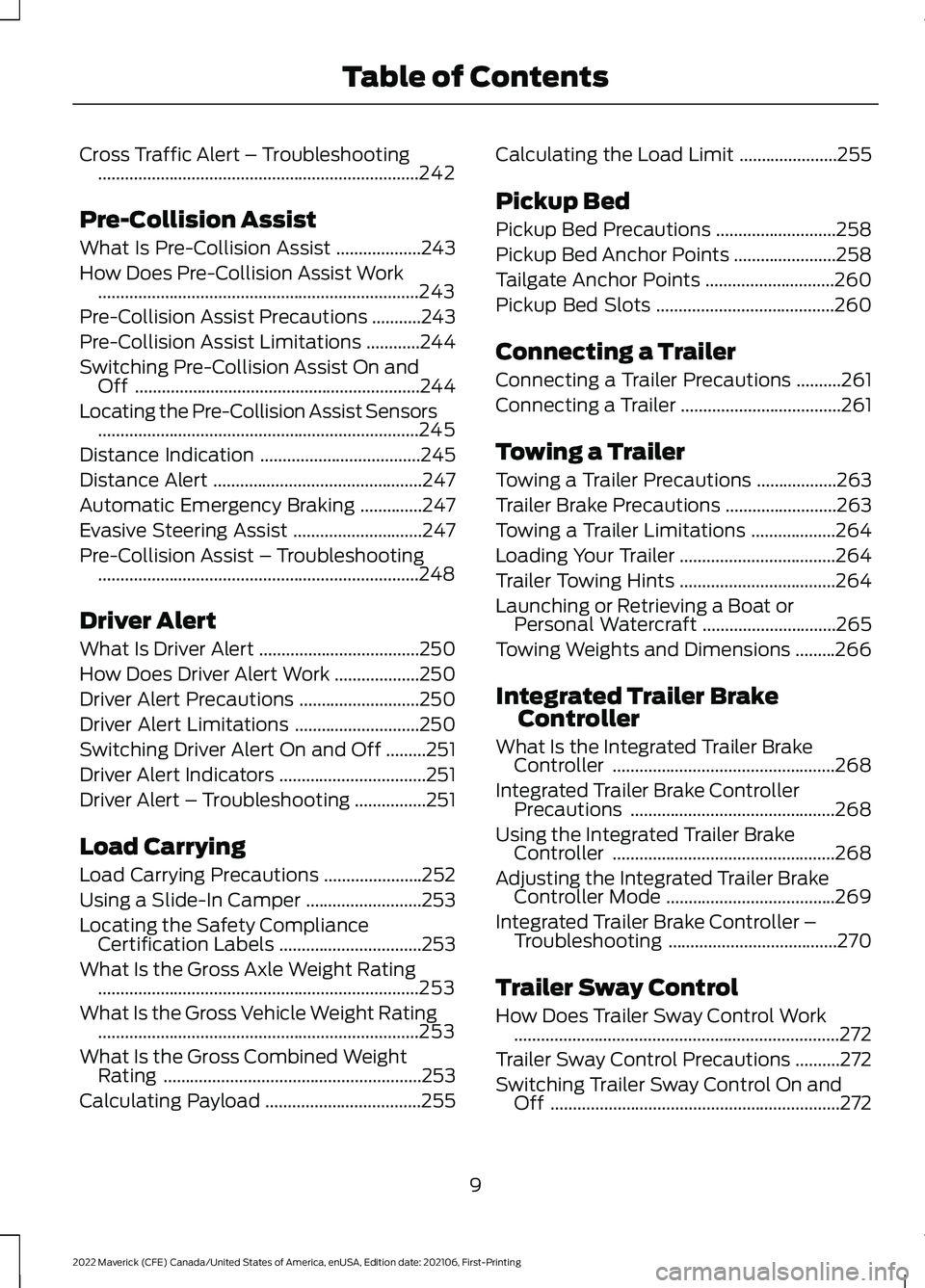
Cross Traffic Alert – Troubleshooting
........................................................................\
242
Pre-Collision Assist
What Is Pre-Collision Assist ...................
243
How Does Pre-Collision Assist Work ........................................................................\
243
Pre-Collision Assist Precautions ...........
243
Pre-Collision Assist Limitations ............
244
Switching Pre-Collision Assist On and Off ................................................................
244
Locating the Pre-Collision Assist Sensors ........................................................................\
245
Distance Indication ....................................
245
Distance Alert ...............................................
247
Automatic Emergency Braking ..............
247
Evasive Steering Assist .............................
247
Pre-Collision Assist – Troubleshooting ........................................................................\
248
Driver Alert
What Is Driver Alert ....................................
250
How Does Driver Alert Work ...................
250
Driver Alert Precautions ...........................
250
Driver Alert Limitations ............................
250
Switching Driver Alert On and Off .........
251
Driver Alert Indicators .................................
251
Driver Alert – Troubleshooting ................
251
Load Carrying
Load Carrying Precautions ......................
252
Using a Slide-In Camper ..........................
253
Locating the Safety Compliance Certification Labels ................................
253
What Is the Gross Axle Weight Rating ........................................................................\
253
What Is the Gross Vehicle Weight Rating ........................................................................\
253
What Is the Gross Combined Weight Rating ..........................................................
253
Calculating Payload ...................................
255Calculating the Load Limit
......................
255
Pickup Bed
Pickup Bed Precautions ...........................
258
Pickup Bed Anchor Points .......................
258
Tailgate Anchor Points .............................
260
Pickup Bed Slots ........................................
260
Connecting a Trailer
Connecting a Trailer Precautions ..........
261
Connecting a Trailer ....................................
261
Towing a Trailer
Towing a Trailer Precautions ..................
263
Trailer Brake Precautions .........................
263
Towing a Trailer Limitations ...................
264
Loading Your Trailer ...................................
264
Trailer Towing Hints ...................................
264
Launching or Retrieving a Boat or Personal Watercraft ..............................
265
Towing Weights and Dimensions .........
266
Integrated Trailer Brake Controller
What Is the Integrated Trailer Brake Controller ..................................................
268
Integrated Trailer Brake Controller Precautions ..............................................
268
Using the Integrated Trailer Brake Controller ..................................................
268
Adjusting the Integrated Trailer Brake Controller Mode ......................................
269
Integrated Trailer Brake Controller – Troubleshooting ......................................
270
Trailer Sway Control
How Does Trailer Sway Control Work ........................................................................\
.
272
Trailer Sway Control Precautions ..........
272
Switching Trailer Sway Control On and Off .................................................................
272
9
2022 Maverick (CFE) Canada/United States of America, enUSA, Edition date: 202106, First-Printing Table of Contents
Page 13 of 533
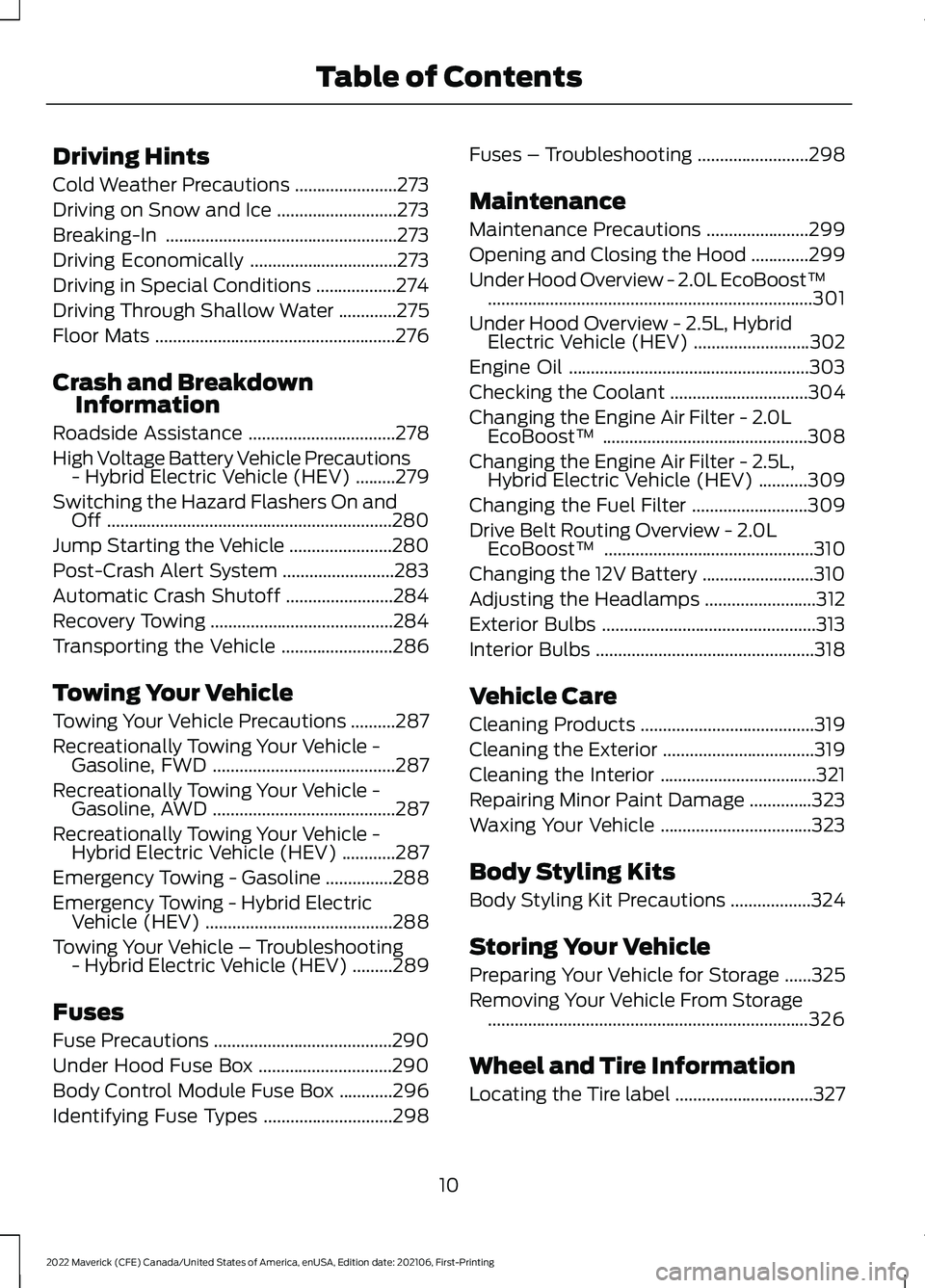
Driving Hints
Cold Weather Precautions
.......................273
Driving on Snow and Ice ...........................
273
Breaking-In ....................................................
273
Driving Economically .................................
273
Driving in Special Conditions ..................
274
Driving Through Shallow Water .............
275
Floor Mats ......................................................
276
Crash and Breakdown Information
Roadside Assistance .................................
278
High Voltage Battery Vehicle Precautions - Hybrid Electric Vehicle (HEV) .........
279
Switching the Hazard Flashers On and Off ................................................................
280
Jump Starting the Vehicle .......................
280
Post-Crash Alert System .........................
283
Automatic Crash Shutoff ........................
284
Recovery Towing .........................................
284
Transporting the Vehicle .........................
286
Towing Your Vehicle
Towing Your Vehicle Precautions ..........
287
Recreationally Towing Your Vehicle - Gasoline, FWD .........................................
287
Recreationally Towing Your Vehicle - Gasoline, AWD .........................................
287
Recreationally Towing Your Vehicle - Hybrid Electric Vehicle (HEV) ............
287
Emergency Towing - Gasoline ...............
288
Emergency Towing - Hybrid Electric Vehicle (HEV) ..........................................
288
Towing Your Vehicle – Troubleshooting - Hybrid Electric Vehicle (HEV) .........
289
Fuses
Fuse Precautions ........................................
290
Under Hood Fuse Box ..............................
290
Body Control Module Fuse Box ............
296
Identifying Fuse Types .............................
298Fuses – Troubleshooting
.........................
298
Maintenance
Maintenance Precautions .......................
299
Opening and Closing the Hood .............
299
Under Hood Overview - 2.0L EcoBoost™ ........................................................................\
.
301
Under Hood Overview - 2.5L, Hybrid Electric Vehicle (HEV) ..........................
302
Engine Oil ......................................................
303
Checking the Coolant ...............................
304
Changing the Engine Air Filter - 2.0L EcoBoost™ ..............................................
308
Changing the Engine Air Filter - 2.5L, Hybrid Electric Vehicle (HEV) ...........
309
Changing the Fuel Filter ..........................
309
Drive Belt Routing Overview - 2.0L EcoBoost™ ...............................................
310
Changing the 12V Battery .........................
310
Adjusting the Headlamps .........................
312
Exterior Bulbs ................................................
313
Interior Bulbs .................................................
318
Vehicle Care
Cleaning Products .......................................
319
Cleaning the Exterior ..................................
319
Cleaning the Interior ...................................
321
Repairing Minor Paint Damage ..............
323
Waxing Your Vehicle ..................................
323
Body Styling Kits
Body Styling Kit Precautions ..................
324
Storing Your Vehicle
Preparing Your Vehicle for Storage ......
325
Removing Your Vehicle From Storage ........................................................................\
326
Wheel and Tire Information
Locating the Tire label ...............................
327
10
2022 Maverick (CFE) Canada/United States of America, enUSA, Edition date: 202106, First-Printing Table of Contents
Page 157 of 533
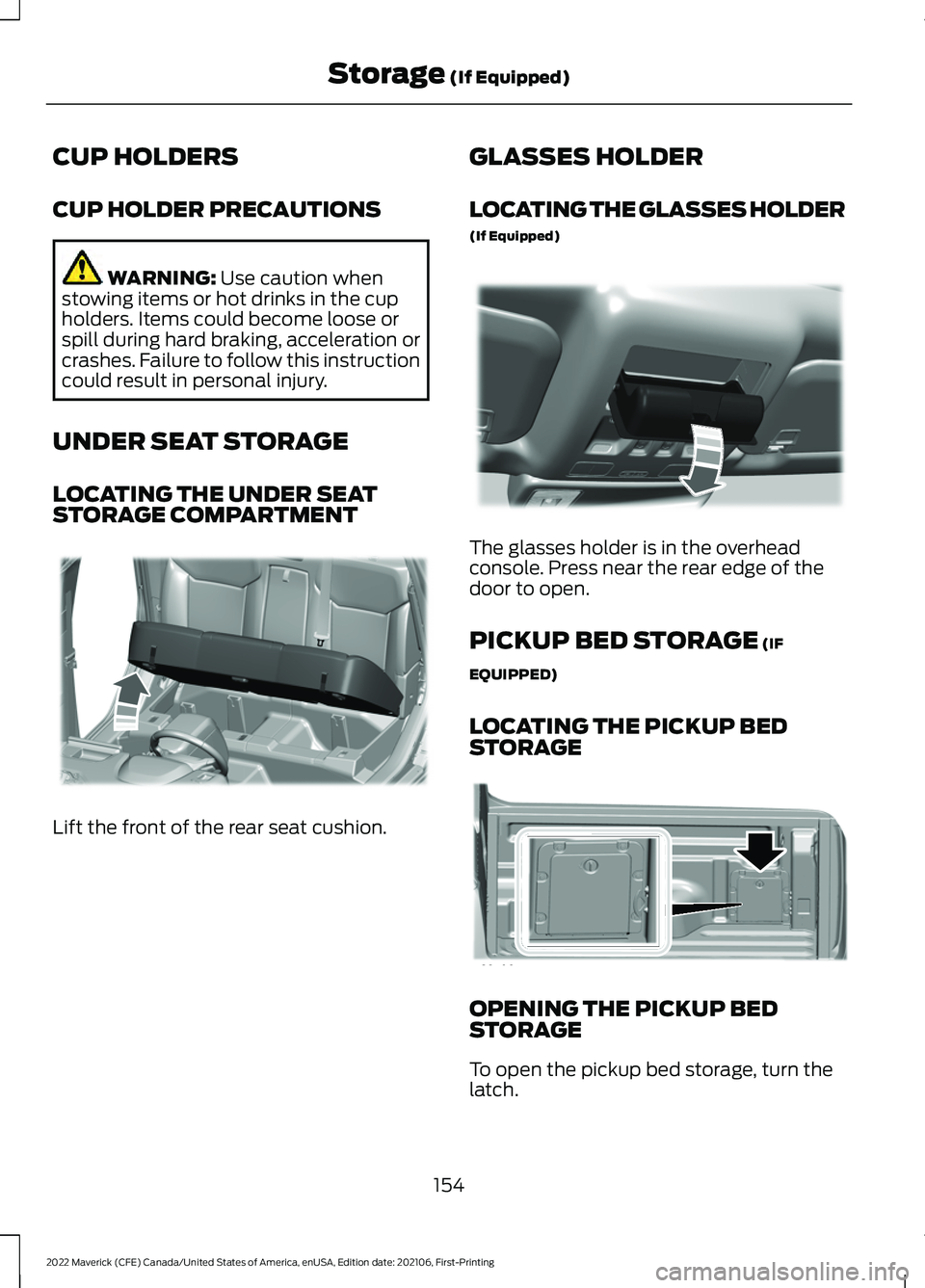
CUP HOLDERS
CUP HOLDER PRECAUTIONS
WARNING: Use caution when
stowing items or hot drinks in the cup
holders. Items could become loose or
spill during hard braking, acceleration or
crashes. Failure to follow this instruction
could result in personal injury.
UNDER SEAT STORAGE
LOCATING THE UNDER SEAT
STORAGE COMPARTMENT Lift the front of the rear seat cushion. GLASSES HOLDER
LOCATING THE GLASSES HOLDER
(If Equipped) The glasses holder is in the overhead
console. Press near the rear edge of the
door to open.
PICKUP BED STORAGE
(IF
EQUIPPED)
LOCATING THE PICKUP BED
STORAGE OPENING THE PICKUP BED
STORAGE
To open the pickup bed storage, turn the
latch.
154
2022 Maverick (CFE) Canada/United States of America, enUSA, Edition date: 202106, First-Printing Storage
(If Equipped)E355885 E324912 E354607
Page 169 of 533
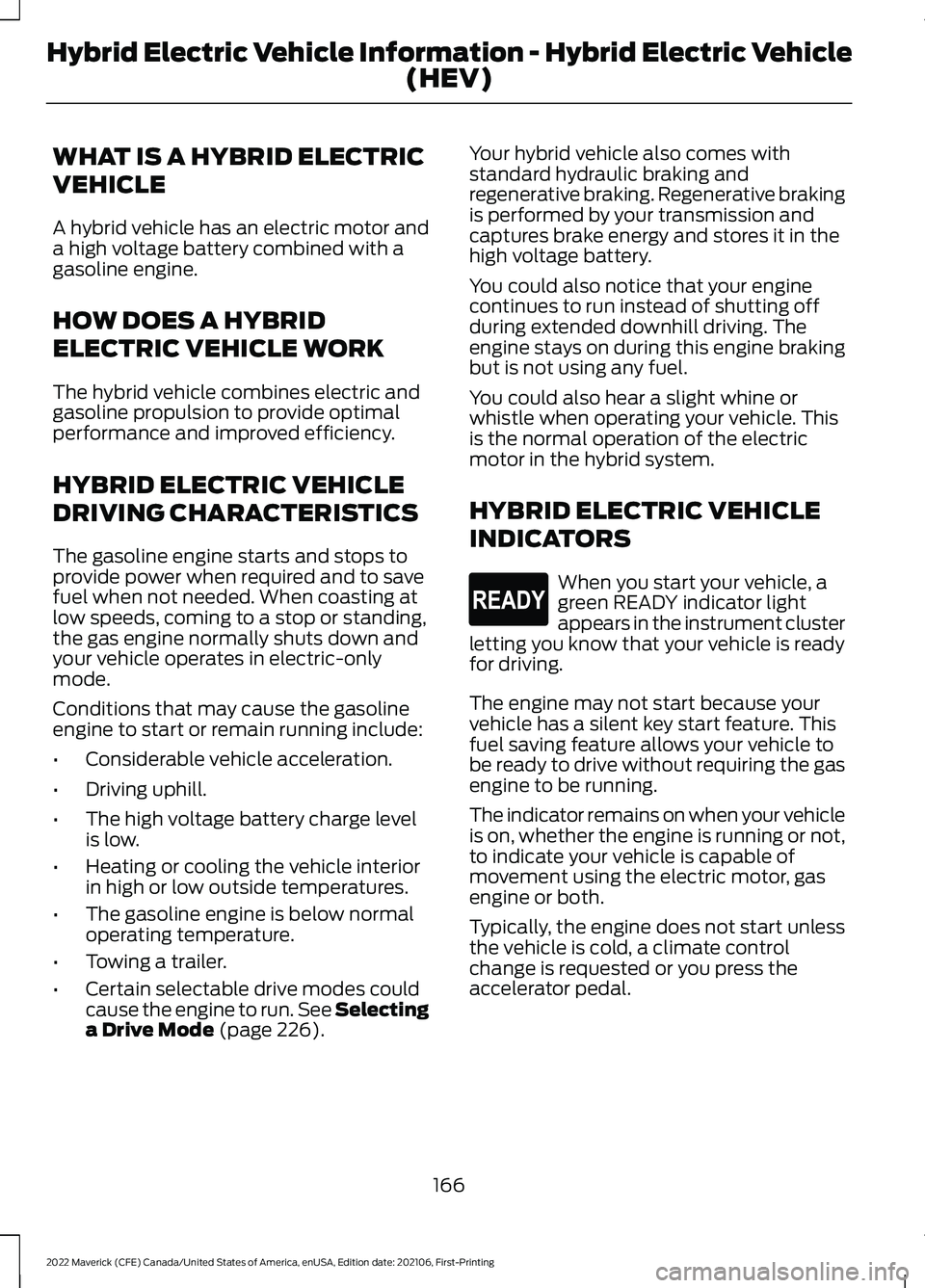
WHAT IS A HYBRID ELECTRIC
VEHICLE
A hybrid vehicle has an electric motor and
a high voltage battery combined with a
gasoline engine.
HOW DOES A HYBRID
ELECTRIC VEHICLE WORK
The hybrid vehicle combines electric and
gasoline propulsion to provide optimal
performance and improved efficiency.
HYBRID ELECTRIC VEHICLE
DRIVING CHARACTERISTICS
The gasoline engine starts and stops to
provide power when required and to save
fuel when not needed. When coasting at
low speeds, coming to a stop or standing,
the gas engine normally shuts down and
your vehicle operates in electric-only
mode.
Conditions that may cause the gasoline
engine to start or remain running include:
•
Considerable vehicle acceleration.
• Driving uphill.
• The high voltage battery charge level
is low.
• Heating or cooling the vehicle interior
in high or low outside temperatures.
• The gasoline engine is below normal
operating temperature.
• Towing a trailer.
• Certain selectable drive modes could
cause the engine to run. See Selecting
a Drive Mode (page 226). Your hybrid vehicle also comes with
standard hydraulic braking and
regenerative braking. Regenerative braking
is performed by your transmission and
captures brake energy and stores it in the
high voltage battery.
You could also notice that your engine
continues to run instead of shutting off
during extended downhill driving. The
engine stays on during this engine braking
but is not using any fuel.
You could also hear a slight whine or
whistle when operating your vehicle. This
is the normal operation of the electric
motor in the hybrid system.
HYBRID ELECTRIC VEHICLE
INDICATORS
When you start your vehicle, a
green READY indicator light
appears in the instrument cluster
letting you know that your vehicle is ready
for driving.
The engine may not start because your
vehicle has a silent key start feature. This
fuel saving feature allows your vehicle to
be ready to drive without requiring the gas
engine to be running.
The indicator remains on when your vehicle
is on, whether the engine is running or not,
to indicate your vehicle is capable of
movement using the electric motor, gas
engine or both.
Typically, the engine does not start unless
the vehicle is cold, a climate control
change is requested or you press the
accelerator pedal.
166
2022 Maverick (CFE) Canada/United States of America, enUSA, Edition date: 202106, First-Printing Hybrid Electric Vehicle Information - Hybrid Electric Vehicle (HEV)E293827
Page 175 of 533
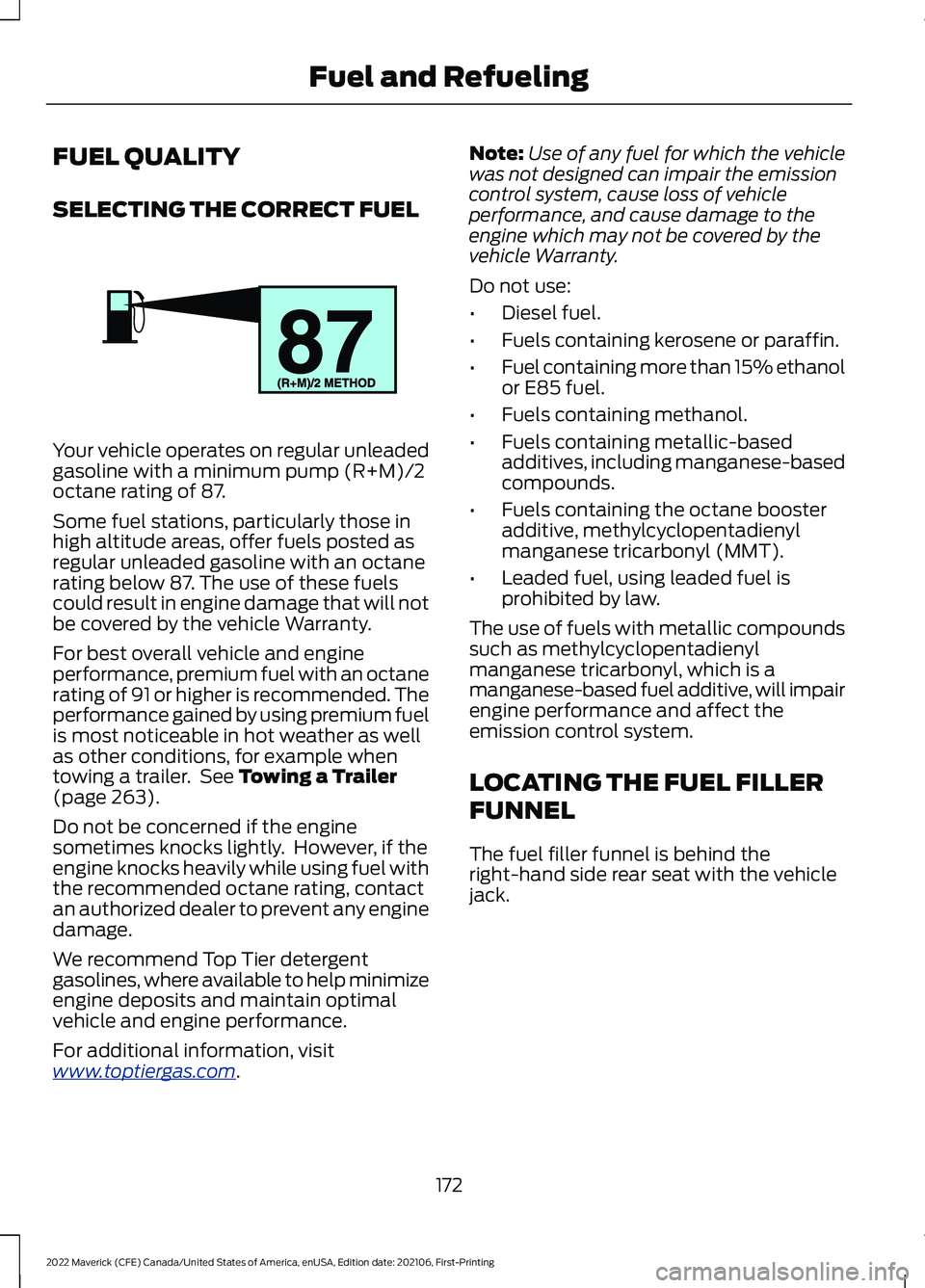
FUEL QUALITY
SELECTING THE CORRECT FUEL
Your vehicle operates on regular unleaded
gasoline with a minimum pump (R+M)/2
octane rating of 87.
Some fuel stations, particularly those in
high altitude areas, offer fuels posted as
regular unleaded gasoline with an octane
rating below 87. The use of these fuels
could result in engine damage that will not
be covered by the vehicle Warranty.
For best overall vehicle and engine
performance, premium fuel with an octane
rating of 91 or higher is recommended. The
performance gained by using premium fuel
is most noticeable in hot weather as well
as other conditions, for example when
towing a trailer. See Towing a Trailer
(page 263).
Do not be concerned if the engine
sometimes knocks lightly. However, if the
engine knocks heavily while using fuel with
the recommended octane rating, contact
an authorized dealer to prevent any engine
damage.
We recommend Top Tier detergent
gasolines, where available to help minimize
engine deposits and maintain optimal
vehicle and engine performance.
For additional information, visit
www .t op tier g a s. c om . Note:
Use of any fuel for which the vehicle
was not designed can impair the emission
control system, cause loss of vehicle
performance, and cause damage to the
engine which may not be covered by the
vehicle Warranty.
Do not use:
• Diesel fuel.
• Fuels containing kerosene or paraffin.
• Fuel containing more than 15% ethanol
or E85 fuel.
• Fuels containing methanol.
• Fuels containing metallic-based
additives, including manganese-based
compounds.
• Fuels containing the octane booster
additive, methylcyclopentadienyl
manganese tricarbonyl (MMT).
• Leaded fuel, using leaded fuel is
prohibited by law.
The use of fuels with metallic compounds
such as methylcyclopentadienyl
manganese tricarbonyl, which is a
manganese-based fuel additive, will impair
engine performance and affect the
emission control system.
LOCATING THE FUEL FILLER
FUNNEL
The fuel filler funnel is behind the
right-hand side rear seat with the vehicle
jack.
172
2022 Maverick (CFE) Canada/United States of America, enUSA, Edition date: 202106, First-Printing Fuel and RefuelingE161513
Page 190 of 533
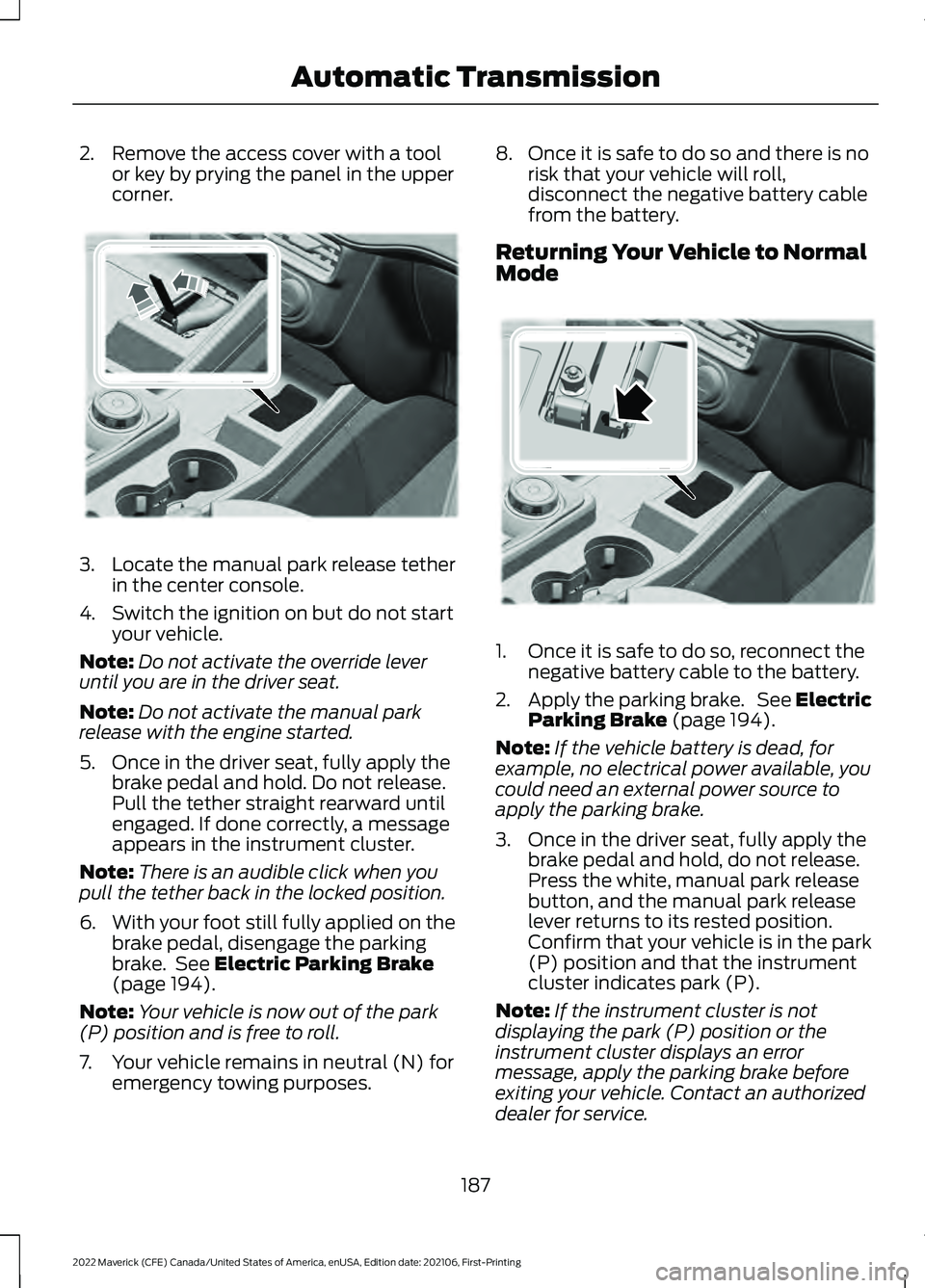
2. Remove the access cover with a tool
or key by prying the panel in the upper
corner. 3.
Locate the manual park release tether
in the center console.
4. Switch the ignition on but do not start your vehicle.
Note: Do not activate the override lever
until you are in the driver seat.
Note: Do not activate the manual park
release with the engine started.
5. Once in the driver seat, fully apply the brake pedal and hold. Do not release.
Pull the tether straight rearward until
engaged. If done correctly, a message
appears in the instrument cluster.
Note: There is an audible click when you
pull the tether back in the locked position.
6. With your foot still fully applied on the
brake pedal, disengage the parking
brake. See Electric Parking Brake
(page 194).
Note: Your vehicle is now out of the park
(P) position and is free to roll.
7. Your vehicle remains in neutral (N) for emergency towing purposes. 8. Once it is safe to do so and there is no
risk that your vehicle will roll,
disconnect the negative battery cable
from the battery.
Returning Your Vehicle to Normal
Mode 1. Once it is safe to do so, reconnect the
negative battery cable to the battery.
2. Apply the parking brake. See Electric
Parking Brake
(page 194).
Note: If the vehicle battery is dead, for
example, no electrical power available, you
could need an external power source to
apply the parking brake.
3. Once in the driver seat, fully apply the brake pedal and hold, do not release.
Press the white, manual park release
button, and the manual park release
lever returns to its rested position.
Confirm that your vehicle is in the park
(P) position and that the instrument
cluster indicates park (P).
Note: If the instrument cluster is not
displaying the park (P) position or the
instrument cluster displays an error
message, apply the parking brake before
exiting your vehicle. Contact an authorized
dealer for service.
187
2022 Maverick (CFE) Canada/United States of America, enUSA, Edition date: 202106, First-Printing Automatic TransmissionE356795 E356796
Page 197 of 533

WHAT IS THE ELECTRIC
PARKING BRAKE
The electric parking brake is used to hold
your vehicle on slopes and flat roads.
APPLYING THE ELECTRIC
PARKING BRAKE
WARNING: Always fully apply the
parking brake and make sure you shift
into park (P). Failure to follow this
instruction could result in personal injury
or death. WARNING:
If you drive extended
distances with the parking brake applied,
you could cause damage to the brake
system. WARNING:
The electric parking
brake does not operate if the vehicle
battery has run out of charge. The electronic parking brake
switch is on the center console.
1. Pull the switch up.
The red warning lamp flashes during
operation and illuminates when the parking
brake is applied.
Note: You can apply the electric parking
brake when the power is off.
Note: The electric parking brake could
apply when you shift into park (P).
See Park
(P) (page 183). APPLYING THE ELECTRIC
PARKING BRAKE IN AN
EMERGENCY
You can use the electric parking brake to
slow or stop your vehicle in an emergency.
1. Pull the switch up and hold it.
The electric parking brake continues to
slow your vehicle down unless you release
the switch.
The red warning lamp illuminates, a tone
sounds and the stoplamps turn on when
you use the electric parking brake in an
emergency.
Note:
Do not apply the electric parking
brake when your vehicle is moving, except
in an emergency.
MANUALLY RELEASING THE
ELECTRIC PARKING BRAKE
1. Switch the ignition on.
2. Press and hold the brake pedal.
3. Push the switch down.
The red warning lamp turns off.
Pulling Away on a Hill When Towing a
Trailer
1. Press and hold the brake pedal.
2. Pull the switch upward and hold it.
3. Shift into gear.
4. Press the accelerator pedal until engine
has developed sufficient torque to
prevent your vehicle from rolling down
the hill.
5. Release the switch and pull away in a normal manner.
194
2022 Maverick (CFE) Canada/United States of America, enUSA, Edition date: 202106, First-Printing Electric Parking BrakeE267156
Page 213 of 533
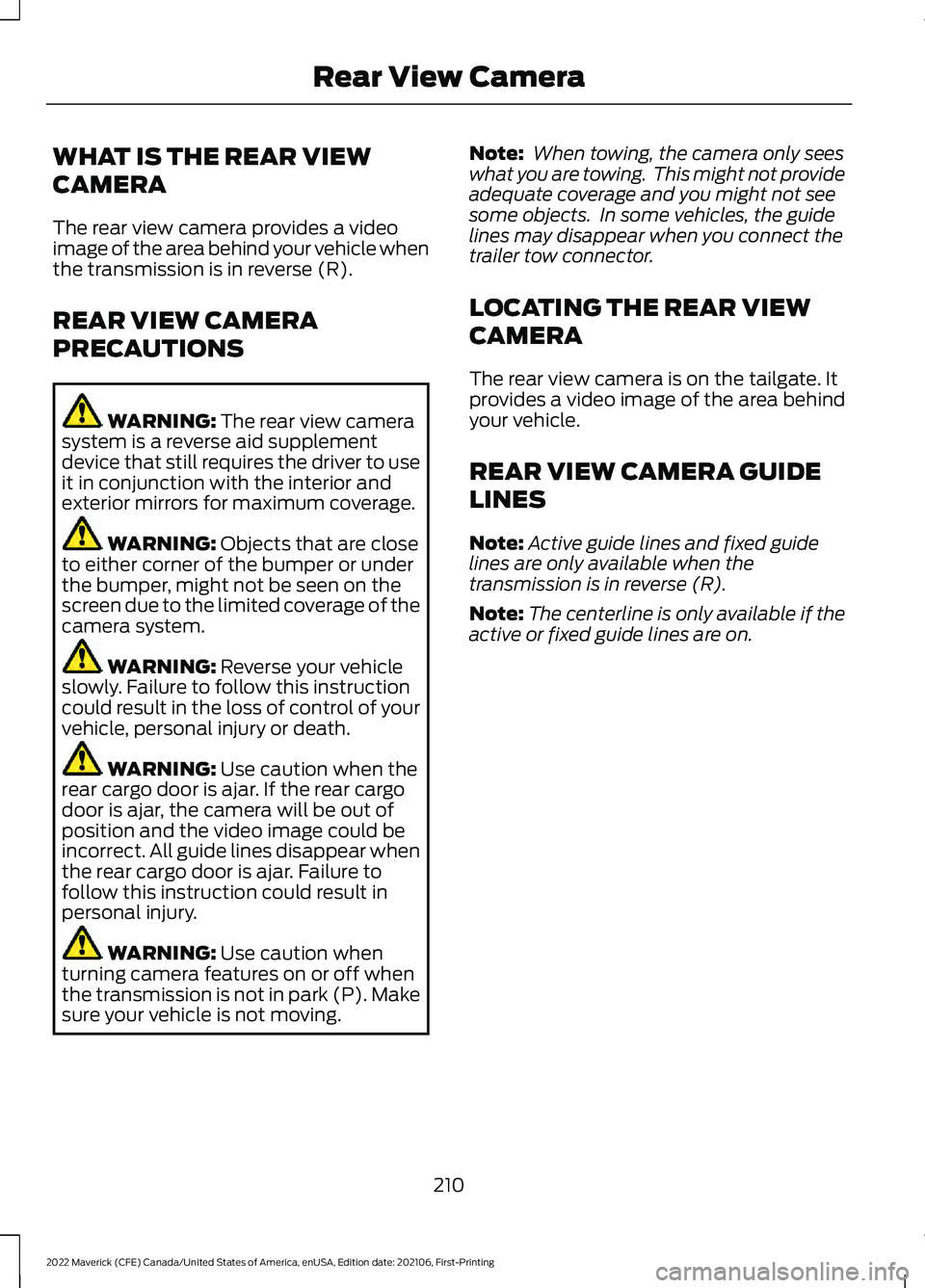
WHAT IS THE REAR VIEW
CAMERA
The rear view camera provides a video
image of the area behind your vehicle when
the transmission is in reverse (R).
REAR VIEW CAMERA
PRECAUTIONS
WARNING: The rear view camera
system is a reverse aid supplement
device that still requires the driver to use
it in conjunction with the interior and
exterior mirrors for maximum coverage. WARNING:
Objects that are close
to either corner of the bumper or under
the bumper, might not be seen on the
screen due to the limited coverage of the
camera system. WARNING:
Reverse your vehicle
slowly. Failure to follow this instruction
could result in the loss of control of your
vehicle, personal injury or death. WARNING:
Use caution when the
rear cargo door is ajar. If the rear cargo
door is ajar, the camera will be out of
position and the video image could be
incorrect. All guide lines disappear when
the rear cargo door is ajar. Failure to
follow this instruction could result in
personal injury. WARNING:
Use caution when
turning camera features on or off when
the transmission is not in park (P). Make
sure your vehicle is not moving. Note:
When towing, the camera only sees
what you are towing. This might not provide
adequate coverage and you might not see
some objects. In some vehicles, the guide
lines may disappear when you connect the
trailer tow connector.
LOCATING THE REAR VIEW
CAMERA
The rear view camera is on the tailgate. It
provides a video image of the area behind
your vehicle.
REAR VIEW CAMERA GUIDE
LINES
Note: Active guide lines and fixed guide
lines are only available when the
transmission is in reverse (R).
Note: The centerline is only available if the
active or fixed guide lines are on.
210
2022 Maverick (CFE) Canada/United States of America, enUSA, Edition date: 202106, First-Printing Rear View Camera
Page 218 of 533
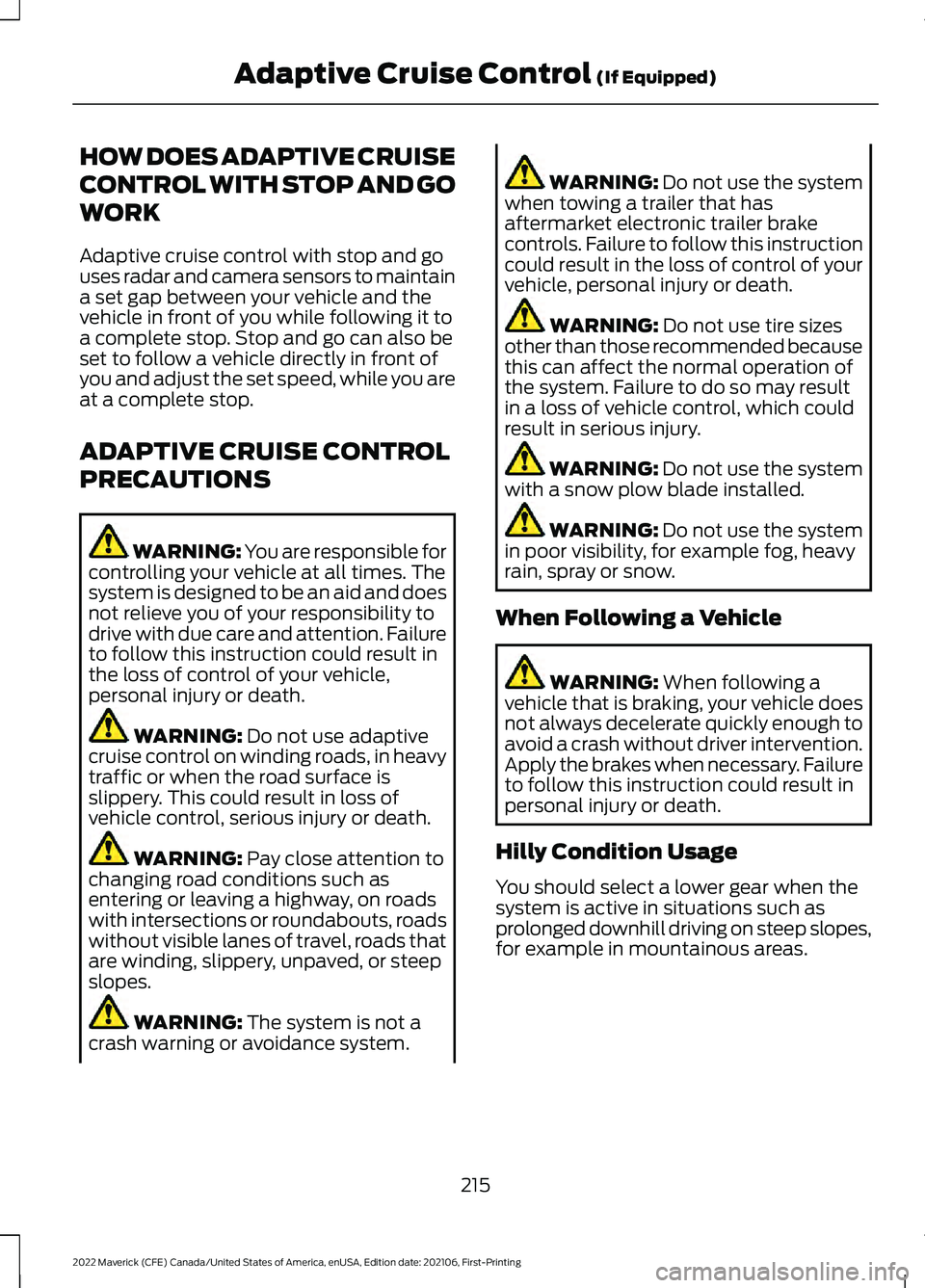
HOW DOES ADAPTIVE CRUISE
CONTROL WITH STOP AND GO
WORK
Adaptive cruise control with stop and go
uses radar and camera sensors to maintain
a set gap between your vehicle and the
vehicle in front of you while following it to
a complete stop. Stop and go can also be
set to follow a vehicle directly in front of
you and adjust the set speed, while you are
at a complete stop.
ADAPTIVE CRUISE CONTROL
PRECAUTIONS
WARNING: You are responsible for
controlling your vehicle at all times. The
system is designed to be an aid and does
not relieve you of your responsibility to
drive with due care and attention. Failure
to follow this instruction could result in
the loss of control of your vehicle,
personal injury or death. WARNING: Do not use adaptive
cruise control on winding roads, in heavy
traffic or when the road surface is
slippery. This could result in loss of
vehicle control, serious injury or death. WARNING:
Pay close attention to
changing road conditions such as
entering or leaving a highway, on roads
with intersections or roundabouts, roads
without visible lanes of travel, roads that
are winding, slippery, unpaved, or steep
slopes. WARNING:
The system is not a
crash warning or avoidance system. WARNING:
Do not use the system
when towing a trailer that has
aftermarket electronic trailer brake
controls. Failure to follow this instruction
could result in the loss of control of your
vehicle, personal injury or death. WARNING:
Do not use tire sizes
other than those recommended because
this can affect the normal operation of
the system. Failure to do so may result
in a loss of vehicle control, which could
result in serious injury. WARNING:
Do not use the system
with a snow plow blade installed. WARNING:
Do not use the system
in poor visibility, for example fog, heavy
rain, spray or snow.
When Following a Vehicle WARNING:
When following a
vehicle that is braking, your vehicle does
not always decelerate quickly enough to
avoid a crash without driver intervention.
Apply the brakes when necessary. Failure
to follow this instruction could result in
personal injury or death.
Hilly Condition Usage
You should select a lower gear when the
system is active in situations such as
prolonged downhill driving on steep slopes,
for example in mountainous areas.
215
2022 Maverick (CFE) Canada/United States of America, enUSA, Edition date: 202106, First-Printing Adaptive Cruise Control
(If Equipped)
Page 225 of 533
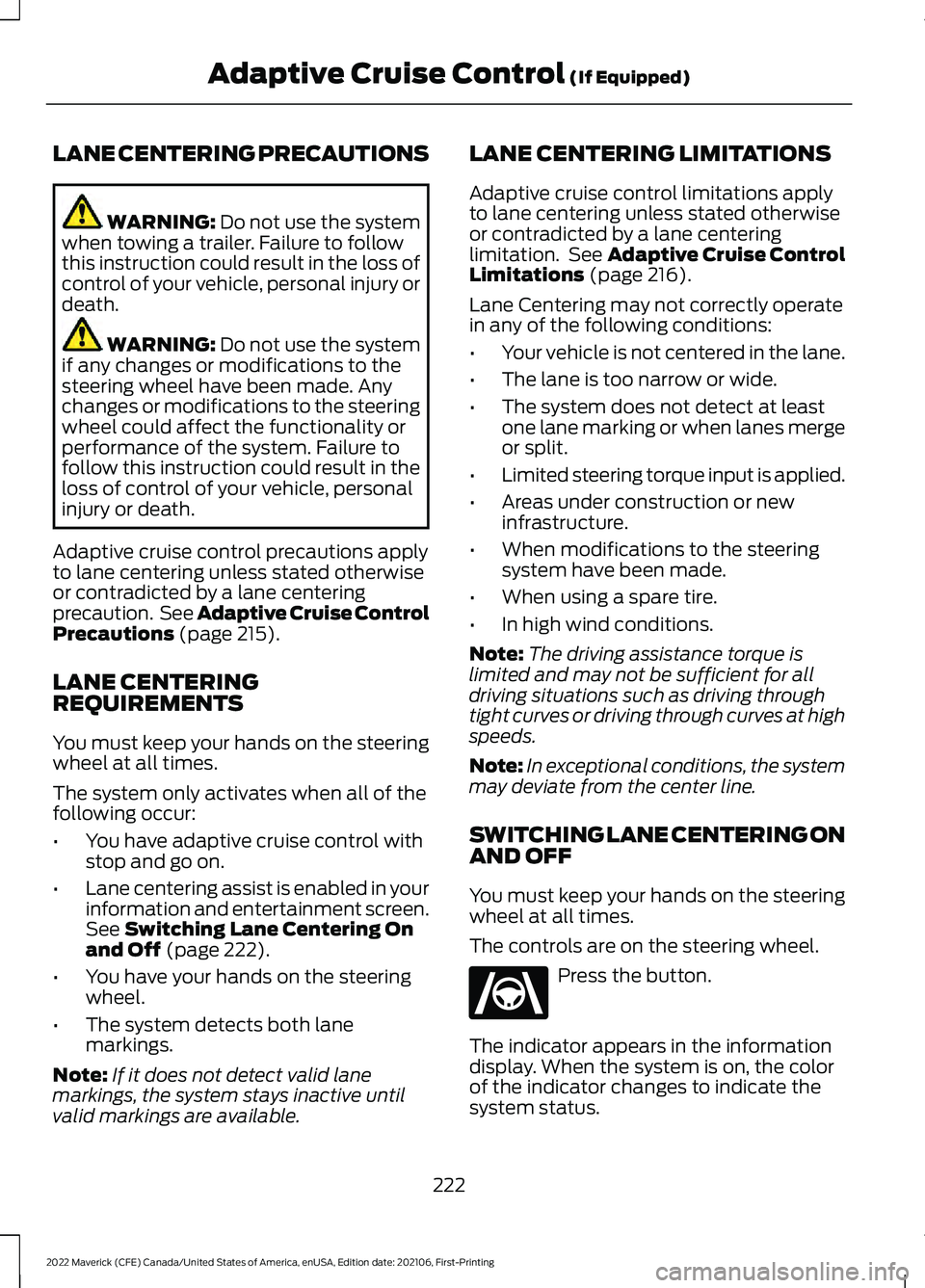
LANE CENTERING PRECAUTIONS
WARNING: Do not use the system
when towing a trailer. Failure to follow
this instruction could result in the loss of
control of your vehicle, personal injury or
death. WARNING:
Do not use the system
if any changes or modifications to the
steering wheel have been made. Any
changes or modifications to the steering
wheel could affect the functionality or
performance of the system. Failure to
follow this instruction could result in the
loss of control of your vehicle, personal
injury or death.
Adaptive cruise control precautions apply
to lane centering unless stated otherwise
or contradicted by a lane centering
precaution. See Adaptive Cruise Control
Precautions
(page 215).
LANE CENTERING
REQUIREMENTS
You must keep your hands on the steering
wheel at all times.
The system only activates when all of the
following occur:
• You have adaptive cruise control with
stop and go on.
• Lane centering assist is enabled in your
information and entertainment screen.
See
Switching Lane Centering On
and Off (page 222).
• You have your hands on the steering
wheel.
• The system detects both lane
markings.
Note: If it does not detect valid lane
markings, the system stays inactive until
valid markings are available. LANE CENTERING LIMITATIONS
Adaptive cruise control limitations apply
to lane centering unless stated otherwise
or contradicted by a lane centering
limitation. See Adaptive Cruise Control
Limitations
(page 216).
Lane Centering may not correctly operate
in any of the following conditions:
• Your vehicle is not centered in the lane.
• The lane is too narrow or wide.
• The system does not detect at least
one lane marking or when lanes merge
or split.
• Limited steering torque input is applied.
• Areas under construction or new
infrastructure.
• When modifications to the steering
system have been made.
• When using a spare tire.
• In high wind conditions.
Note: The driving assistance torque is
limited and may not be sufficient for all
driving situations such as driving through
tight curves or driving through curves at high
speeds.
Note: In exceptional conditions, the system
may deviate from the center line.
SWITCHING LANE CENTERING ON
AND OFF
You must keep your hands on the steering
wheel at all times.
The controls are on the steering wheel. Press the button.
The indicator appears in the information
display. When the system is on, the color
of the indicator changes to indicate the
system status.
222
2022 Maverick (CFE) Canada/United States of America, enUSA, Edition date: 202106, First-Printing Adaptive Cruise Control
(If Equipped)E262175